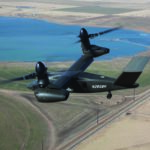NRO Launches. Rocket Lab says that its Electron rocket is ready to carry the National Reconnaissance Office’s (NRO) “Antipodean Adventure” NROL-199 mission to orbit on Aug. 2. The rocket is to lift off from the Pad B at Rocket Lab Launch Complex 1 in New Zealand. The NRO built the payload with the Australian Department of Defense, and the Aug. 2 launch would mark the second Rocket Lab launch in less than a month, as an Electron rocket carried the NROL-162 payload to orbit on July 12. The rocket for NROL-199 “was originally scheduled for lift-off on July 22, but the launch was rescheduled to allow the NRO additional time to implement required payload software updates,” Rocket Lab said. “This schedule shift demonstrated Rocket Lab’s responsive space capabilities, which provide customers with a high degree of flexibility over their mission, including orbit and launch timing. By operating a private launch complex, Rocket Lab doesn’t have to wait in a launch queue behind other operators and could instead quickly reschedule the launch to suit the NRO’s preferred timeline.”
…Final SBIRS. The final Lockheed Martin Space Based Infrared System (SBIRS) is to launch aboard a United Launch Alliance (ULA) Atlas V rocket on Aug. 4 from Cape Canaveral Space Force Station, Fla. ULA is a partnership between Lockheed Martin and Boeing. The SBIRS Geosynchronous Earth Orbit-6 (SBIRS GEO-6) is to help provide missile warning and tracking until the U.S. fields the Lockheed Martin Next Generation Overhead Persistent Infrared (Next-Gen OPIR) system and/or a Tracking Layer of low Earth orbit and medium Earth orbit satellites. Lockheed Martin said that technology on SBIRS GEO-6 will feed the design of Next-Gen OPIR for the missile warning mission, “which has become more critical as ballistic missile technology has proliferated around the world with over 1,000 missile launches tracked annually.” Lockheed Martin said that it recognizes “that modernized technology is needed to augment the current missile warning architecture.”
ACV Update. After moving to pause all waterborne operations with its Amphibious Combat Vehicles (ACV) following a training incident with two vehicles, the Marine Corps said it has now authorized ACV water operations in protected waters only, such as Area 21, Del Mar Boat Basin at Camp Pendleton in California. The decision was made following an initial review of the July 19 incident in which two ACVs, which are built by BAE Systems, became disabled in heavy surf. No injuries were reported from the incident. The Marine Corps reiterated that ACV operations remain suspended for open ocean and surf, while ACV land operations are still authorized as normal.
KMW/Elbit. German defense firm Krauss-Maffei Wegmann has announced it’s signed a memorandum of understanding with Elbit Systems Deutschland and Elbit Systems Land to expand strategic cooperation, specifically related to work on modernization of the European Multiple Launch Rocket System (MLRS). “I very much welcome the cooperation with Elbit. With this partnership we underline the potential of our MLRS. The associated capability enhancements make this artillery rocket system one of the most modern worldwide,” Ralf Ketzel, chairman of the KMW Management Board, said in a statement. KMW said, under the deal, Elbit will provide a modern active agent portfolio so that the requirements of MLRS users can be fully met, from range-enhanced rockets to practice ammunition.”
Army On OpFires. Doug Bush, the Army’s top acquisition official, told reporters this week the Army does not currently have a requirement that matches with DARPA’s Operational Fires (OpFires) program to develop a hypersonic missile capability to be ground-launched from logistics trucks, but said the service is “watching it with interest.” “I’m aware of [OpFires]. I actually went to DARPA a few weeks ago, got a briefing on that and several other things. So the Army’s well aware of it. We don’t currently have a requirement for that system in the Army,” Bush said. DARPA announced earlier this month it had conducted a successful first flight test with OpFires, which included the first time launching from a Marine Corps logistics truck and using Army artillery fire control systems to initiate the demonstration. OpFires is a Lockheed Martin-built system, which also uses a Northrop Grumman-designed rocket motor.
Tactical AI Funds. The Senate Appropriations Committee’s proposed $792.1 billion FY ‘23 defense spending bill includes an additional $200 million over the budget request for tactical artificial intelligence. The panel wrote the additional allocation is to build on and further work on tactical AI capabilities that “have resulted in notable improvements in the combatant commands’ and department’s ability to utilize data to make informed decisions at greater speed and scale.” “However, additional focus and resources are required to ensure that the artificial intelligence continues to be implemented at the tactical level. In particular, the committee is supportive of additional investments in digital talent, which is integral to future progress in the institutionalization of modern data practices across the department,” the committee wrote in an explanatory statement accompanying its bill. The bill directs that none of the additional funds can be spent until 30 days after the Pentagon’s comptroller provides the congressional defense committees with a plan detailing the proposed activities and associated timelines for tactical AI projects.
Thales Acquires AAC. Thales last week said its Defense & Security subsidiary has completed acquiring full ownership Advanced Acoustic Concepts (AAC), a provider of sonar and training for the U.S. Navy. AAC had been a joint venture between Thales and Leonardo DRS. AAC has more than 200 employees and generated $80 million in sales in 2021. “AAC’s skills and experience in surface ship anti-submarine warfare, airborne ASW, and mine countermeasures will strengthen our support of the U.S. DoD,” said Mike Sheehan, CEO of Thales Defense & Security, Inc. Terms of the deal were not disclosed.
LPD-28. The Navy is set to commission the newest San Antonio-class amphibious transport dock, the future USS Fort Lauderdale (LPD-28), on July 30 in the Port of Fort Lauderdale, Fla. LPD-28 was built by HII at its shipyard in Pascagoula, Miss. The ship was first launched in March 2020, christened in August 2021 and delivered to the Navy in March 2022. Following the commissioning, LPD-28 will sail to its homeport in Naval Station Norfolk, Va. LPDs generally transport and land Marines and their equipment and supplies via embarked Landing Craft Air Cushions (LCACs), conventional landing craft and amphibious assault vehicles and helicopters or vertical take-off and landing aircraft like the MV-22 Osprey. This is the 12th overall San Antonio-class ship.
LSD-41. The Navy held a decommissioning ceremony for the USS Whidbey Island (LSD-41) at Joint Expeditionary Base Little Creek-Fort Story, Va., on July 22 before it is set to be inactivated in August. The ship was first commissioned in February 1985 as the first in its class designed to interface with LCACs. Whidbey Island was the first amphibious ships from the East Coast to deploy to the European theater with LCACs aboard.
T-AKE 13. The Military Sealift Command (MSC) dry cargo ammunition ship USNS Medgar Evers (T-AKE 13) sailed to the Atlantic Ocean to perform Shipboard Qualification Trials (SQT) from July 14-17. The SQT is a series of qualifications, certifications and training evolutions that must be completed and maintained by MSC ships to be considered operational and prepared for deployment. T-AKE 13 must be qualified to primarily deliver fuel, goods, repair parts and supplies to Navy and allied combatant ships via underway replenishment at-sea (UNREP) services. The Medgar Evers performed the SQT with MSC fleet replenishment oiler USNS Kanawha (T-AO 196) and fast combat support ship USNS Arctic (T-AOE 8). T-AKE 13 is crewed by about 100 civilian mariners. Once the ship returns to port, it is slated to undergo a week of pier-side damage control training evolutions. The next few months will include more SQTs so the crew and ship are ready to support Navy needs.
LPD-9 SINKEX. The Navy with Japanese partners conducted a multi-domain sinking exercise (SINKEX) on the ex-USS Denver (LPD-9) decommissioned Austin-class amphibious transport dock ship on July 22 during the Rim of the Pacific (RIMPAC) 2022 exercise. U.S. and Japanese forces sank the ship in waters over 15,000 feet deep and over 50 nautical miles north of the Hawaiian island Kauai. The Navy said this enabled partner nations to gain proficiency in tactics, targeting and live firing against a surface target at sea. In the SINKEX, from the land, the Japanese Ground Self-Defense Force and U.S. Army shot Type 12 surface-to-ship missiles and practice rockets. Also, from the air U.S. Navy F/A-18F Super Hornets shot a long range anti-ship missile; a U.S. Army AH-64 Apache helicopter shot air-to-ground Hellfire missiles, rockets and 30mm guns; Marine Corps F/A-18C/D Hornets fired an air-launched cruise missile, air-to-surface anti-radiation missiles, an air-to-ground anti-radiation missile, and Joint Direct Attack Munitions; and the U.S. Navy guided-missile destroyer USS Chaffee (DDG-90) shot its Mk 45 5-inch gun.
AUKUS Adviser. Secretary of Defense Lloyd Austin named Abraham Denmark to serve as his senior adviser on AUKUS on July 29. The agreement among the U.S., U.K. and Australia aims to help the latter prepare for and field a new class of nuclear-powered submarines as well as share other technologies. In this role, Denmark will advise Austin and coordinator efforts across DoD “to move rapidly in delivering on the promise of this historic partnership to help Australia establish a conventionally armed, nuclear powered submarine capability and to accelerate development of advanced capabilities to serve security and stability in the Indo-Pacific,” Acting Pentagon Press Secretary Todd Breasseale said in a statement. Denmark currently serves as vice president of programs at the Wilson Center and previously served as Deputy Assistant Secretary of Defense for East Asia from 2015 to 2017.
Ammo Plant Upgrades. Senate appropriators also added an additional $250 million above the budget request for modernization of Army ammunition manufacturing facilities, for a total of $749.6 million. The committee noted the Army’s ammunition plant modernization plan outlined $3.8 billion in upgrade requirements over the next five years. “Many of these investments are critical to ensuring increased manufacturing safety, future readiness, and improved sustainability across multiple Department of Defense ammunition programs,” the committee wrote. The bill also directs that none of the funds may be used until 30 days after the Secretary of the Army details to the congressional defense committees how the funds would be spent on specific upgrade efforts. It also directs the Army to submit an updated ammo plan modernization plan with its FY ‘24 budget request. The Army has previously detailed plans to take on a full 15-year, $16 billion organic industrial base modernization effort.
Palantir/Army. Palantir Technologies said on July 28 it has received a two-year deal worth nearly $100 million to continue its work with the Army Research Laboratory to help implement data and artificial intelligence/machine learning capabilities “for users across the combatant commands.” Palantir noted it began this work in 2018 to provide “state-of-the-art operational data and AI capabilities.” “Maintaining a leading edge through technology is foundational to our mission and partnership with the Army Research Laboratory,” Akash Jain, president of Palantir USG, said in a statement. “Our nation’s armed forces require best-in-class software to fulfill their missions today while rapidly iterating on the capabilities they will need for tomorrow’s fight. We are honored to support this critical work by teaming up to deliver the most advanced operational AI capabilities available with dozens of commercial and public sector partners.” Palantir was recently selected, along with Raytheon Technologies, to deliver prototypes for the Army’s Tactical Intelligence Targeting Access Node (TITAN) program.
CISA and Ukraine. Amid Russia’s war against Ukraine, the U.S. Cybersecurity and Infrastructure Security Agency and Ukraine last week signed a memorandum of cooperation to expand on their existing work together in the areas of information exchanges and sharing of best practices on cyber incidents, critical infrastructure security technical exchanges, and cybersecurity training and joint exercises. The agreement “represents an enduring partnership and alignment of defending our shared values through increased real-time information sharing across agencies and critical sectors and committed collaboration in cultivating a resilient partnership,” said Oleksandr Potii, deputy chairman of Ukraine’s State Service of Special Communications and Information Protection.
USV Interest. The Senate Appropriations Committee last week unveiled its proposed fiscal year 2023 spending bill for the Department of Homeland Security that includes provisions aimed at expanding the use of various unmanned systems for the Coast Guard and Customs and Border Protection. The panel directs the Coast Guard to report on its research and development plans for unmanned surface vessels (USVs), including wind and solar-powered vessels with surface and subsurface capabilities. It also directs CBP’s divisions to work with industry on a demonstration of a persistent, long duration maritime domain awareness using USVs “where illicit maritime activity is known to be concentrated.”
Parsons’ Personnel News. Parsons Corp. last week said George Ball, its long-time chief financial officer, is retiring and has been succeeded by Matt Ofilos, who has been the company’s executive vice president of finance since 2021. Ofilos joined Parsons from Amazon Web Services. Parsons also announced that Ball and Ellen Lord will join the company’s board. Ball had been CFO since 2008 and is remaining as an adviser through September. Lord, who at one time led Textron’s Systems segment, served as the Pentagon’s top acquisition official during the Trump administration.













